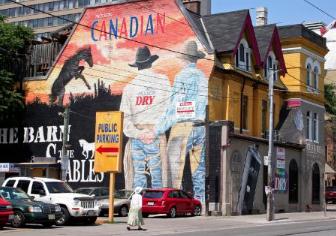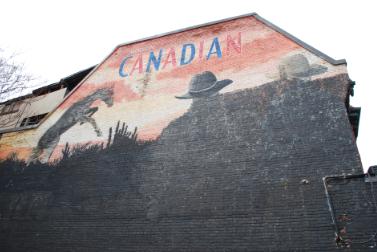
The Barn in 2006. Credit: Jon Lidolt
The iconic gay cowboys mural on the south wall of the old Barn nightclub on Church Street — what many have long seen as the gaybourhood’s southern gateway marker — is gone forever.
The painting, featuring the backside of two cowboys lovingly holding hands, was also an advertisement for Molson Canadian. The cowboys have now been covered over by a layer of black paint.
“This was a beautiful mural . . . I don’t like that it was destroyed,” says community member Joshua Hromek. Hromek assumed the painting was defaced as an act of homophobic vandalism because only half is now covered — the gay half.
But the truth is not quite as violent.
Since the club closed in August, the future of the 19th-century building, and its campy mural, has been up in the air.
Councillor Kristyn Wong-Tam says the building has been sold to a new owner, who recently decided to paint over the mural in preparation to reopen as a pub/restaurant — similar to O’Grady’s up the street.
Wong-Tam says she found out via Twitter on March 11 that the mural was being painted over. She asked the new owner to immediately stop painting, but it was too late. Xtra could not reach the owner for comment at press time.
At the end of the day, says Wong-Tam, painting over the mural was a mistake.
“It’s a heritage property. You should not be altering a heritage-designated property without advising the city,” she says. “Unfortunately, it all happened very quickly.
“[The new owners] were a little surprised that they needed our permission, or at least inform the city.”
Still, she says, heritage-preservation staff view murals as temporary applications. “So they can go up and be removed. And a building owner is within his right to remove the mural.”
Wong-Tam says the owner asked about donating the wall to the Church Street Mural Project, a large-scale outdoor art project currently in the works for the Village.
James Fowler, co-curator of the project, says the Barn’s wall is now one of more than 10 Church Street walls that will soon be canvasses.
Fowler says that sometimes change is good. “That mural is a part of our history, but it’s a very male-centric image. Right now, I see more diversity in the area. And I think a cowboy image is a little dated . . . Maybe now it can become a female-centric wall or a trans-centric wall.”
The mural certainly predates Brokeback Mountain, but Fowler does not know when it first went up, or who painted it.
“Don’t forget, this was an advertisement, designed around branding and product placement,” he says. “Ultimately, I think this is reflective of a change in the community, something that was part of a bar that is no longer there. Preserving history is very important. How we do that may change over time.”
The Barn first opened its doors in 1975 with a restaurant and bar called Les Cavaliers downstairs, says local crime writer James Dubro. He says the mural went up at some point during the management tenure of the Barn’s original owner, Janko Naglic.
“He was very proud of it. I remember that,” he says. “I imagine there was some revenue coming in for that from Molson.”
Dubro says that the mural was a big, splashy and very public expression of homosexuality painted at a time when visibility was not as common, even in the Church Wellesley Village. “It does have a lot of very positive qualities to it. It’s an ad, yes, but compare that to Dundas Square.”
“Was it an eyesore or a great piece of history? It’s probably both,” he says. “But at the time it was also a political statement.”
Much of the history of the mural was likely lost when Naglic was found murdered in his Davisville-area home on Oct 27, 2004, and the Barn was forced to close. The Barn later reopened on Halloween in 2007.
If any local historians know more about the mural, please leave a comment below or email comment@dailyxtra.com.

 Why you can trust Xtra
Why you can trust Xtra


